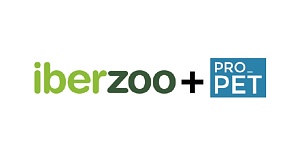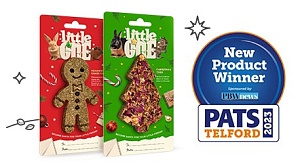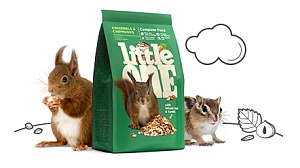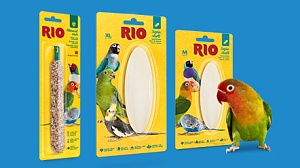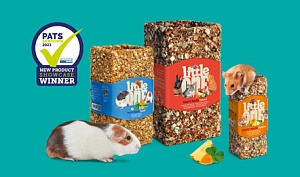Health and happiness in one bowl
In times where more and more people decide to get small animals as pets, especially rabbits, you can find more information, different approaches, and nutritional ideas than ever before: there is the mixed type feeding, the different ingredients mixes, grain-free feeds, pelletized feeds, extruded feeds, the hay and fresh products theory and so on.
Whilst it is great to have a choice, it is becoming more and more complicated for pet parents to navigate between the various types of feed advantages and the ultimate benefit their pet will have from the chosen diet. Some feeding approaches market themself as the best one, so it's even more difficult to find the one that works and is suitable for the pets. The German pet food producer Mealberry is now introducing their Little One feeding concept gradually to the UK market. Little One feeds are a result of the analysis of scientific information and facts, enriched with years of observation and research. This feeding approach combines the best ideas from various nutritional concepts and offers a well-balanced diet without sacrificing the pet’s quality of life.
Little One is going away from the mainstream ideas and focuses on actual scientifically proven approaches. So, let’s have a look and dive into the main ideas and research that shape the Little One feeding concept.
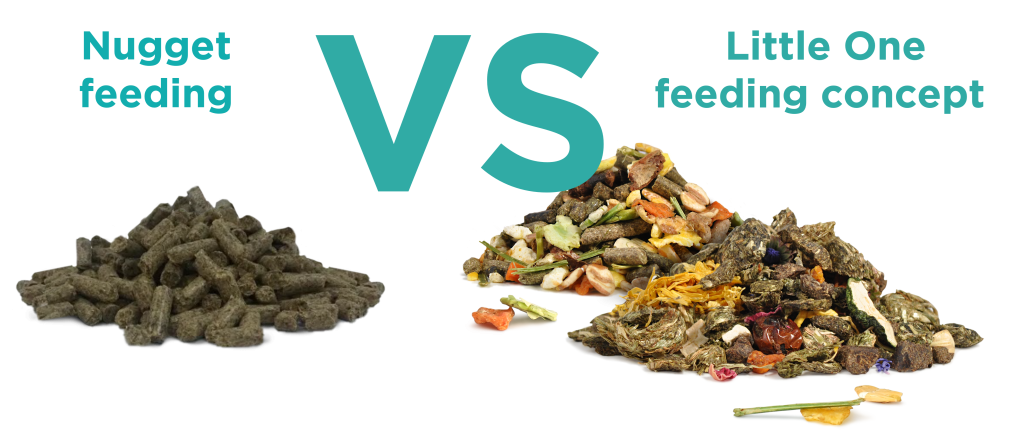
Pet rabbits are not laboratory animals!
One of the theories claims that rabbits will only eat the yummy ingredients in the mixed type feeds such as dried fruit and vegetables or the flaked and puffed ones, but leave the supposedly less tasty pellets uneaten, which has led to the rise of the nugget type feeding concepts. So, despite all the trends and efforts to offer a diet like in nature, pets fed with just nuggets are treated as homogeneous ‘machines’ whose nutritional needs must be met in a prescribed manner which repeats during every meal.
Pet parents are led to believe that the best choice for their pet is feeding mono-pellets during their entire life. Arguably this can be a very convenient solution but ultimately this mimics the conditions under which animals in laboratories are raised and kept.
Let’s have a look at some research, for example, 1 study (1) shows that when given the choice between a pelleted diet and a pelleted diet with an appetizer, rabbits will generally prefer the latter. The study also shows that the daily feed intake and growth performance are exactly the same on either of the diets.
The conclusion is that pleasant tastes do not seem to have an impact on the feed intake and therefore it is preferable to choose a feed with a variety of ingredients instead of mono-pellets.
The Little One feeding concept rejects the principle of mono-pellets as this goes completely against the animals’ normal grazing behavior and significantly reduces the pets’ quality of life. Little One believes that a diverse content of the daily feed is needed to prevent food boredom, which can lead to different deviations in normal behavior in pets kept on a pelleted diet with an unchanging recipe during their entire life.
What’s on your plate Mr. Bunny?
Having a closer look at the pellets or nuggets a rabbit owner is probably faced with a lot of questions. Such as: what grass has been used to make the pellets? Was it fresh hay and grass or was it the leftovers from the previous season? Was the grass still green when it went into the pellets or had it already lost some of its color and therefore part of its nutritional value? Are the linseeds defatted and in case whole seeds are used during production, which antioxidant is used to stabilize the oil? For buyers of mono-pellets / nuggets it can be quite difficult to receive comprehensive answers to these and many other questions. Just like most consumers and pet parents don’t actually know what is hidden behind terms like ‘derivatives of vegetable origin’ or ‘vegetable origin’ or ‘vegetable protein extracts’.
Feeding mixed type feeds with varied ingredients will show the pet parent at one glance what has gone into the feed and of what quality the ingredients are. Each and every single one is visible and can be recognized. The consumer will be able to spot immediately if there is the preferred variation and freshness of the ingredients they would like to have for their animal. The absence of small particles or crushed components is an additional indicator for the high quality of the product and the care that is taken during the production process.
Another positive aspect of stepping away from the laboratory way of feeding pets is being able to take the natural grazing behavior into account. Little One feeds follow a nutritional concept that offers a great variety of tastes, colours and textures, it is a well-balanced and species appropriate diet that supplies the animal with all necessary nutrients and more.
Back to nature! Back to variety! Just balance everything!
Usually, pet owners who follow a grain-free nutritional concept believe that herbivorous animals should only be allowed hay, grasses, leaves and flowers. Feeding grains and cereals is viewed as unnatural, since, allegedly, rabbits are not able to digest them. Looking at statements like these, one needs to bear in mind that the feeding behavior of rabbits in the wild is still a subject of ongoing research and scientific studies and there are still quite a few gaps in what is known about it. What is for certain is that rabbits adapt very well to various feeding environments, from desert to moderate and even cold climates, they are able to consume and digest a wide variety of food, ranging from seeds all the way to herbaceous plants. Grains and some root vegetables have a higher energy density than fresh grass and will therefore be preferable for the rabbits and reflect their survival instincts. It is to be said that such foods contain quite a lot of starch, but for example the one coming from untreated grains is well digested by rabbits even at high levels (>60g/kg of barley in the diet, which is quite a lot). Obviously, a constant supply of such quantities will lead to undesirable fermentation patterns in the caecum (2). Having said all of that, the above principle can be applied to literally every food or ingredient, as the well-being and health of an animal does not depend on what (species appropriate) food or component is eaten but rather on how much of it is consumed.
Appreciating the different believes and views when it comes to diets and grains and seeds, Little One offers two nutritional approaches, which cater for all preferences.
The Little One main range of feeds contains only a limited and calculated amount of starch (in accordance with the FEDIAF). In this feed cereal grains are only used in a flaked or puffed form, this way the structure of the starch gets changed by a technology using heat and a vapor treatment that destroys all anti-nutritional factors. This ensures that all ingredients are easily digestible. As a positive side effect during this process a thermal inactivation of microorganisms occurs, which guarantees an additional microbiological safety.

The Little One grain-free range runs under Little One ‘Green Valley’ and contains more than 60 different Alpine meadow grasses, a variety of herbs, petals of wild and garden flowers, healthy vegetables, and different fruit and berries which are loaded with vitamins. All Green Valley products are made with a gentle cold pressing production process which retains the natural structure of the meadow grasses and preserves most beneficial vitamins and minerals that can be found in those plants.

Let’s talk about fiber. But not only the quantity… It is the quality that matters!
The importance of fiber for herbivorous animals cannot be stressed enough. It is known that rabbits digest fiber poorly due to selective separation and rapid excretion. However, rabbits do require a generous amount of fiber to ensure intestinal motility and to minimize the risk of diseases. As shown in scientific studies (3, 4) a diet with < 12% of crude fiber will almost always result in digestive upset, whilst a diet with >25% of crude fiber may result in increased incidences of caecal impaction and mucoid enteritis. The FEDIAF guidelines for feeding pet rabbits recommend that their diet should contain 14% to 25% of fiber for adult animals and 14% to 16% when feeding junior rabbits. It is also mentioned that in addition to the daily feed ration other sources such as manufactured food, forage, fresh vegetables and treats may also contribute to the amount of fiber in the diet.
The total amount of fiber in the Little One feeds is accurately calculated in accordance with the scientifically estimated recommendations: Little One feed contains 16% and Little One Green Valley contains 24% of fiber. It goes without saying that an unlimited access to hay is recommended.
But not only the amount of fiber contained in the feed is important, the source of where the fiber is coming from plays a pivotal role!
It is a known fact that for technological reasons during the traditional production process of extruded or pressed pellets grass is added in the form of powder, meal or even other grass pellets. This process happens under quite high temperatures in order to get pellets of the desired quality in terms of hardness. As a result of these high temperatures many natural vitamins are partially or completely destroyed, and they need to be added back into the pellet in form of a concentrated premix. The heat treatment during the pellet production process also starts the lipid oxidation of the fats, making it necessary to add antioxidants, which only makes the composition of the pellets/ nuggets more complicated.
All components of the Little One Green Valley feed base are specially developed and produced by using a unique technology, which saves the structure of the grasses and its long tissue fibers, without milling them into powder. The pet parents will be able to easily identify this core structure of the long grasses by just looking at the feed. Thanks to the low temperatures used during the Green Valley production process most of the beneficial vitamins and minerals, that can be found in the plants, will be preserved. Additionally, the dried veggies, flowers and petals contain many more vitamins and phytochemicals in their natural form, which is better tolerated by
the animals.
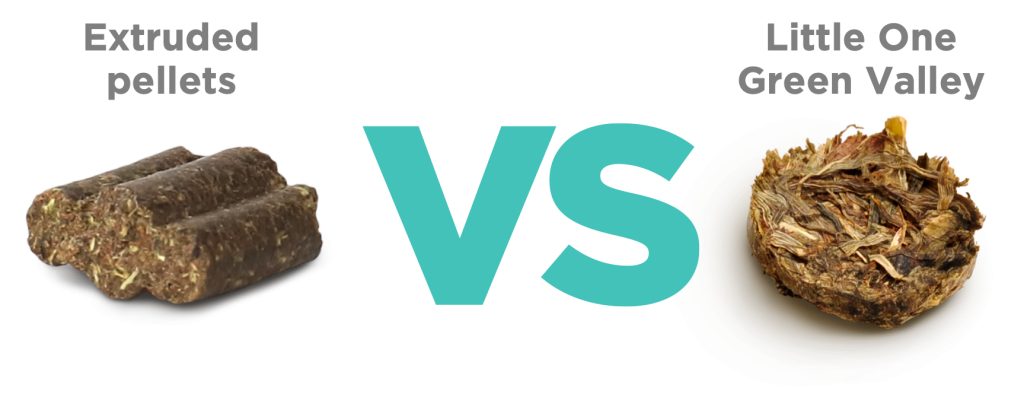
No chance of obesity!
Is there any connection between the feeding approach and weight gain? You will find plenty of scientific research on this topic (5, 6, 7).
In summary the conclusion of all these studies is that any type of feed offered without limitations or in inappropriate quantities will lead to a weight gain in pet animals. This is true for any feeding concept. It is the responsibility of the feed producer to carefully calculate the energy values and nutritional proportions of the feed so that the pet parents just need to follow the recommended feeding guide.
To keep any adult animal healthy and happy they need to be fed in a controlled way that is based on the ideal weight of the breed and the individual body condition.
In summary it can be said that nutritional science is moving forward and delivers constantly more and more evidence that a combination of the advantages of the different feeding approaches delivers better results for the animals’ health and well- being. The Little One feeding concept believes that a varied and balanced diet, offered in appropriate quantities, is the key to cover all nutritional requirements of the pet and will ensure a long, happy and healthy life. The more ingredients, the more different tastes, smells, shapes and textures are offered to explore and enjoy, the more the pets’ diet will be enriched with vitamins, minerals and phytochemicals in their most digestible and natural form. This is how a pet animal should be treated, following a natural approach, not laboratory conditions.
[1] Fekete, S. and Lebas, F. (1983) Effect of a natural flavour (thyme extract) on the spontaneous feed ingestion, digestion coefficients and fattening parameters. Magyar Allatow Lapja 38, 121–125.
[2] Nutrition of the rabbit / edited by Carlos de Blas and Julian Wiseman. - 2nd ed. p. cm.
[3] Gidenne, T. (2003) Fibres in rabbit feeding for digestive troubles prevention. Livestock Production Science 81, 105–117.
[4] Fraser, C.M. (1991) Merck Veterinary Manual, 7th edn. Merck & Co., Rahway, New Jersey, USA, pp. 1278.
[5] Prebble, J.L., Shaw, D., Meredith, A. (2015) The effect of four different feeding regimes on rabbit behaviour. Applied animal behaviour Science, vol. 169, pp. 88-92.
[6] Prebble, J.L., Shaw, D., Meredith, A.L. (2015) Body weight and body score in rabbits on four different feeding regimes. J. Small Animal Practice, 56(3), pp. 207-212.
[7] Legendre, H., Goby, J.-P., Duprat, A., Gidenne, T., Martin, G. (2019) Herbage intake and growth of rabbits under different pasture type, herbage allowance and quality conditions in organic production. Animal, 13:3, pp. 495-501.
